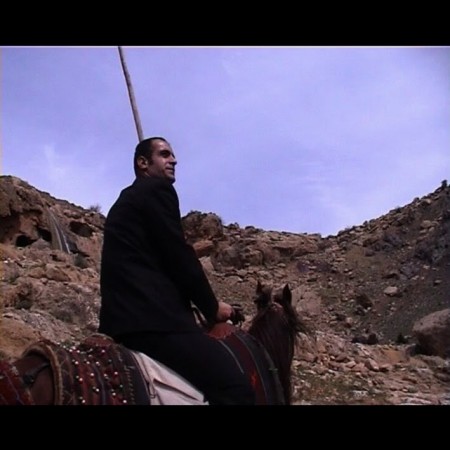
Şener Özmen with Erkan Özgen, "Tate'e Giden Yol (Road to Tate Modern)," video, 7'13" (still), 2003. Courtesy the artist and Outlet-Istanbul.
While preparing to travel to Diyarbakır, the largest city in southeastern Turkey, I discovered that telling Turkish people who live outside of that region that you’re going to visit Diyarbakır is akin to telling an average suburban American you’re going to hang out in an inner city housing project or along the wall dividing Israel and Palestine. Their eyes grow big, there’s a lot of gasping and “ooooh”ing, and they ask you, incredulously, “why would you want to go to Diyarbakır? It’s very dangerous there, you know.” Some treated it a bit like I was going on safari–a worthwhile, possibly exotic and educational, endeavor, as long as I had the proper guidance–and protection. Because Diyarbakır is not only the largest city in southeastern Turkey but also the capital of Kurdish culture in Turkey and the epicenter of a significant amount of violence throughout the 1980s and 1990s, inevitably the news of my travels sparked conversation about “the Kurdish question”–that is, the question of what freedoms and rights ethnic Kurds living in Turkey should be granted. For example, since the founding of the Republic, teaching Kurdish in schools and printing or broadcasting media in Kurdish has been outlawed, and celebration of Newroz, the Kurdish New Year, was forbidden. In the past five years some of these restrictions have been eased, but the subject remains controversial, with many über-nationalistic Turks remaining opposed to the reforms.
So why would I want to travel to Diyarbakır? The art scene in Turkey is famously concentrated in Istanbul–what interest could a formally war-torn and politically unstable region of the country hold for a yabancı (foreigner)? In fact, Diyarbakır has produced some of the most active, intelligent, and influential figures in contemporary Turkish art. These would include artist and curator Halil Altındere, Berat Isik, Ahmet Öğüt (who, along with Banu Cennetoğlu, represented Turkey at the 53rd Venice Biennale in 2009) as well as Suat Öğüt and Mehmet Öğüt, Erkan Özgen, and Cengiz Tekin. (Fikret Atay, another well-known Kurdish artist, actually hails from Batman, a smaller city located about two hours from Diyarbakır.) All of these artists have exhibited extensively both throughout Turkey and internationally. But the godfather of the Diyarbakır art community is undoubtedly Şener Özmen. For the past twenty years, Özmen has worked not only as an artist but also as a poet, art critic, translator, and teacher. He collaborates constantly with his fellow Diyarbakır-based artists, has nurtured a new generation of artists, produces texts for exhibition catalogues, designs covers for Lîs Publishing (a prominent Kurdish language publishing house based in Diyarbakır), writes fiction and poetry, and supports the work of the Diyarbakır Arts Centre. In an essay included in the recently published monograph A Sener Ozmen Book, critic Süreyyya Evren describes him as “an artist who cannot relax.” When I visited Diyarbakır, I was honored that Özmen took the time from his busy professional and personal life (he is also a father and husband) to serve, along with Cengiz Tekin, as an attentive and wildly entertaining host. At one point, while we were riding a dolmuş (mini-bus) from Diyarbakır to have breakfast at Hasankeyf, a historical site located on the Tigris River (which, sadly, is likely to be destroyed in the near future by a hydroelectric dam project), Özmen casually remarked that this was the first day off from work that he had ever taken. It sounds like hyperbole, but given his extraordinary output, I am inclined to believe this was true.
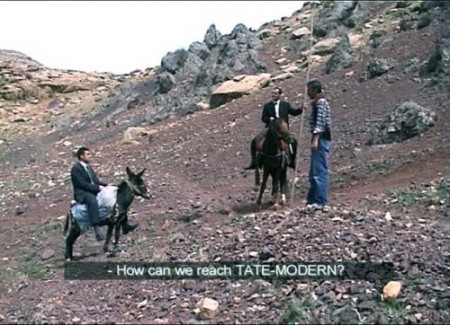
Şener Özmen with Erkan Özgen, "Tate'e Giden Yol (Road to Tate Modern)," video, 7'13" (still), 2003. Courtesy the artist and Outlet-Istanbul.
I first encountered Özmen’s work at the Istanbul Modern, where I saw his best known work to date, Tate’e Giden Yol (Road to Tate Modern), produced in 2003 in collaboration with Erkan Özgen. In the video Özmen plays a Don Quixote-like figure who, clothed in a suit and tie and armed with a giant lance, rides on horseback through the dusty, rocky mountains of southeastern Turkey in search of the Tate Modern. Though we learn that Özmen and his sidekick (played by Özgen), who follows Özmen astride a donkey, have been traveling for forty days and forty nights, we only see them stop to wash themselves in a mountain stream, carefully removing their highly polished shoes and dress socks in order to wash their feet. On their way they encounter another traveler who is on foot. They hail him in Kurdish and ask him if he can direct them to the Tate Modern. It’s to the left, he tells them, over the mountains. Over the mountains? they ask. Is it far? Yes, he responds, it is very far, but you can make it.

Şener Özmen with Erkan Özgen, "Tate'e Giden Yol (Road to Tate Modern)," video, 7'13" (stills), 2003. Courtesy the artist and Outlet-Istanbul.
Though the goal represented in Road to Tate Modern–journeying via horseback to any place very far from Diyarbakır, much less London–is completely absurd, the earnestness and naiveté with which the protagonists doggedly pursue their objective is both charming and heartbreaking, as the viewer understands–as the protagonists do not–the impossibility of their mission. (But then again who knows? Perhaps horseback is the perfect way to reach the Tate Modern.) This work establishes many of the reoccurring themes of Özmen’s oeuvre: the use of the arid landscape surrounding Diyarbakır as not only a setting but as a symbolic touchstone; restless movement, the inability to stay in a fixed location unless hiding; concern with questions of periphery and center; and the deployment of humor or absurdity as way to protect the view (and perhaps Özmen himself) against the painful reality–the lived experience of Kurds living in Turkey and all people living in that particular region–to which his works speak.
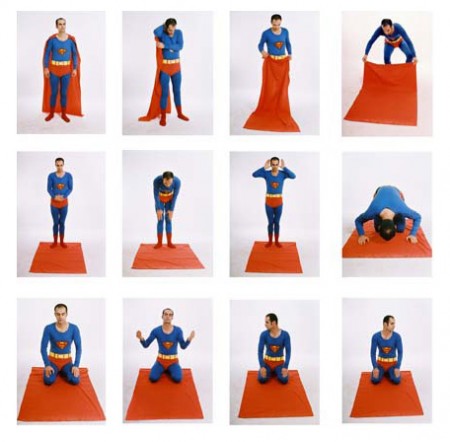
Şener Özmen, "Süper Müslüman (Supermuslim)," photograph (series of 12 images), 2003. Courtesy the artist and Outlet-Istanbul.
This humor plays a similarly important role in another of Özmen’s most well known works, Süper Müslüman (Supermuslim), a series of twelve photographs in which Özmen , dressed in a homemade Superman costume, removes his “cape” and uses it as a prayer rug, going through the ritual movements of Islamic prayer. The hilarity of this act, of the recasting of an American pop culture icon, the ultimate symbol of heroic, masculine strength, as a devote Muslim draws attention to just how much distance currently exists between what we understand as “American” and anything associated with Islam. The humorous reaction we experience in viewing Supermuslim is in large part a symptom of the cognitive dissonance that occurs when we see the ultimate American hero conflated with Islam. At the same time this inability to see Islam as copasetic with American ideals is exactly the mindset that has facilitated the so-called “War On Terror,” which, when viewed in tandem with reports of American military personnel and civilians alike burning and defacing copies of the Quran, continues to look a lot like a war on Islam, regardless of the actual intent.
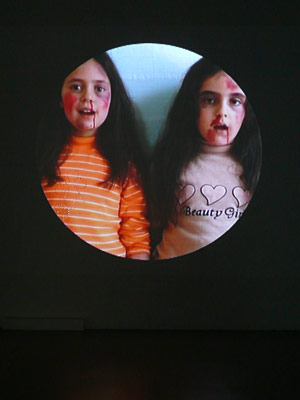
Şener Özmen, "Köyümüz (Our Village)," video, 7'09" (still), 2004. Courtesy the artist and Outlet-Istanbul.
Because so much of Özmen’s work features not only himself but friends, colleagues, family members, and the immediate environs to which he is so intimately connected, there is also a palpably personal aspect to his work that resonates cleanly with the viewer, regardless of the politics or seemingly local/regional issues that are also at hand. For example, the 2004 video piece titled Köyümüz (Our Village) features two young girls (who happen to be Özmen’s nieces) singing a children’s song in Kurdish. Rather than featuring the sort of innocent lyrics normally associated with children’s songs, the two girls sing about their poverty, their father’s illness and inability to work, and their inability to attend school. Over the course of the seven minute video the song is sung three times; as it progresses through the repetitions, the girls’ faces slowly change, becoming covered in bruises and blood. In addition, the camera appears to be shooting through a round frame, reminiscent of both a gun’s sight and the close cropping technique used by studio photographers in creating sentimental portraits in the early days of photography. Are the girls being targeted by some anonymous villain? Or is Özmen drawing our attention to the act of representation and the dynamics at work when we watch the pain of others? As critic and curator Barbara Heinrich points out, “The source of the violence remains unclear. Rather, these traces appear to stand for the latent violence of social relations, from which there is no escape.” Our Village serves as a reminder that, despite the official state of détente in the region, violence remains an embedded part of daily existence, a reality that both predates the political conflict and lingers on as an unhappy inheritance.
In a conversation with Özmen and critic İz Öztat included in A Sener Özmen Book, gallerist Azra Tüzünoğlu remarks upon two recent shifts in Özmen’s work: the discontinuing of the use of the landscape around Diyarbakır as a primary pictorial technique, and the withdrawal of Özmen himself as a subject of or character in his pieces. Özmen points to the 2009 photograph Kavşak (Crossroads) as a turning point, the moment in which this shift began. In the photograph, Özmen crouches in a parking lot, head in hand, staring fixedly at his reflection in a puddle of rainwater pooled on the pavement. In the background rise mounds of earth, which seem to be part of an unseen construction site. Behind them rise the ghostly outlines of what may be either television and cellular towers or trees—in either case, signs of life and progress, building and growth. To his left lie a sheath of papers, not only put down but literally cast aside so that he might engage in this moment of self-scrutiny. While Tüzünoğlu reads this as a reenactment of the Greek myth of Narcissus, in which a beautiful man becomes so enamored with his own image reflected in a pool of water that he falls into it and drowns, it seems to me as if Özmen may be literally looking for himself, to see how he fits into Diyarbakır’s new landscape. The trauma of war is no longer an external struggle against an armed enemy, whether visible or concealed, but an internal one, in which those left behind must decide how to cope with the events of the past and move into an uncertain future.
Part of this process for Özmen would seem to mean, for the first time, creating works set outside of Diyarbakır. When we last spoke, he reported that he was working on a new body of videos, in collaboration with his long-time creative partner Cengiz Tekin, being shot in Gaziantep, another large city in southeastern Turkey located very close the border with Syria. (Diyarbakır is further north, closer to the Turkish-Iraqi border.) Undoubtedly these works will continue Özmen’s engagement with issues of identity and the politics of geography and culture, but this shift in locale will inevitably bring up not only new themes and subjects but present new aesthetic opportunities and challenges.

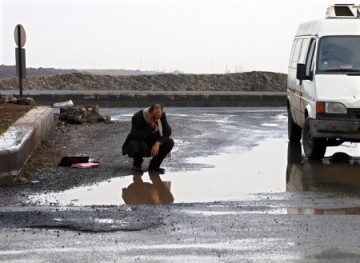



Pingback: Turkish and Other Delights | Cengiz Tekin | Art21 Blog